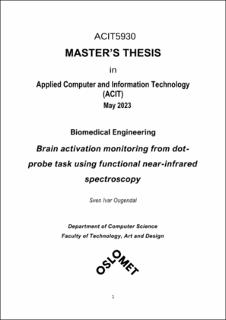| dc.description.abstract | Over the past decade, there has been a notable increase of 13% in mental health issues. Approximately one in five children and adolescents globally suffer from a mental health problem, with suicide ranking as the second most common cause of death for individuals aged 15-29. Cognitive biases, such as attentional bias (AB), may contribute to the onset and persistence of mental health disorders. AB can be defined as the tendency to selectively attend to or focus on certain stimuli while ignoring others, where someone with a negative AB have a disproportional attention to negative stimuli. The dot-probe task is one of the most widely used tasks to measure AB. Understanding the underlying neural processes involved in AB and identifying reliable biomarkers may be important in developing successful interventions for mental health disorders. This master's thesis aimed to setup an experiment laboratory to investigate AB and its underlying neural mechanisms using a combined approach of hybrid functional near-infrared spectroscopy (fNIRS)/eye-tracking (ET) and hybrid electroencephalography (EEG)/ET systems in conjunction with the dot-probe task. A large-scale experiment was conducted, and a multi-subject analysis was done on the fNIRS data, which focused on detecting significant variations in oxyhemoglobin (HbO) and deoxyhemoglobin (HbR) concentrations between congruent and incongruent dot-probe trials in the prefrontal cortex (PFC) and visual cortex regions of the brain. The results of the multi-subject general linear model (GLM) analysis revealed two significant findings: (1) a higher HbR concentration in the right ventral medial PFC when the dot is located behind the fearful face compared to when it is behind the neutral face, and (2) a higher HbR concentration in the right dorsal PFC when the dot is positioned behind a face expressing emotion compared to when it is behind a neutral face. These findings highlight the potential of using fNIRS to study AB. | en_US |
